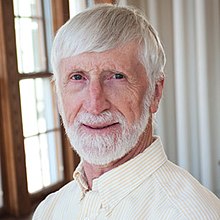Andrew J. Hanson | |
|---|---|
 | |
| Born | 1944 (age 79–80) |
| Alma mater | •Harvard College •MIT |
| Known for | Eguchi-Hanson space |
| Awards | 2nd place in Gravity Research Foundation contest in 1979 |
| Scientific career | |
| Fields | •Physics •Computer Science |
| Institutions | •Postdoctoral: Institute for Advanced Study, Cornell, SLAC National Accelerator Laboratory, and Lawrence Berkeley National Laboratory •Indiana University |
| Doctoral advisor | Kerson Huang[1] |
| Website | Andrew J. Hanson's Home Page |
Andrew J. Hanson (born 1944) is an American theoretical physicist and computer scientist. Hanson is best known in theoretical physics as the co-discoverer of the Eguchi–Hanson metric,[2] the first Gravitational instanton. This Einstein metric is asymptotically locally Euclidean and self-dual, closely parallel to the Yang-Mills instanton. He is also known as the co-author of Constrained Hamiltonian Systems[3] and of Gravitation, Gauge Theories, and Differential Geometry,[4] which attempted to bridge the gap between theoretical physicists and mathematicians at a time when concepts relevant to the two disciplines were rapidly unifying. His subsequent work in computer science focused on computer graphics and visualization of exotic mathematical objects, including widely used images of the Calabi-Yau quintic cross-sections used to represent the hidden dimensions of 10-dimensional string theory. He is the author of Visualizing Quaternions[5] and Visualizing More Quaternions.[6]
- ^ Andrew J. Hanson at the Mathematics Genealogy Project
- ^ Eguchi, Tohru; Hanson, Andrew J. (1978-04-10). "Asymptotically flat self-dual solutions to euclidean gravity" (PDF). Physics Letters B. 74 (3): 249–251. Bibcode:1978PhLB...74..249E. doi:10.1016/0370-2693(78)90566-X. ISSN 0370-2693. OSTI 1446816. S2CID 16380482.
- ^ Hanson, Andrew J.; Regge, Tullio; Teitelboim, Claudio (1976). Constrained Hamiltonian Systems. Accademia Nazionale dei Lincei.
- ^ Eguchi, Tohru; Gilkey, Peter B.; Hanson, Andrew J. (1980-12-01). "Gravitation, gauge theories and differential geometry". Physics Reports. 66 (6): 213–393. Bibcode:1980PhR....66..213E. doi:10.1016/0370-1573(80)90130-1. ISSN 0370-1573.
- ^ Hanson, Andrew J. (2006). Visualizing Quaternions. San Francisco, CA, USA: Morgan Kaufmann Publishers Inc. ISBN 9780080474779.
- ^ Hanson, Andrew J. (2024). Visualizing More Quaternions. San Francisco, CA, USA: Morgan Kaufmann Publishers Inc. ISBN 9780323992022.